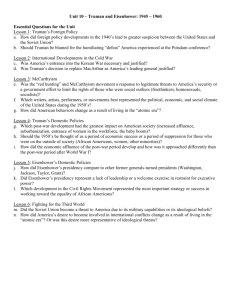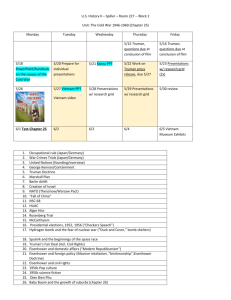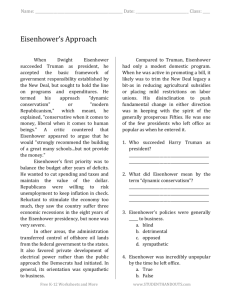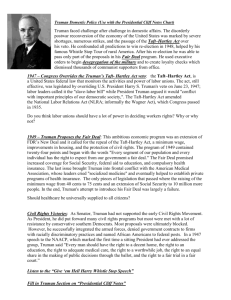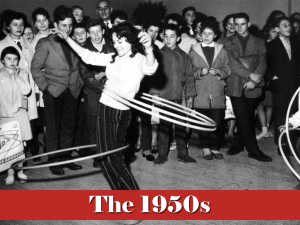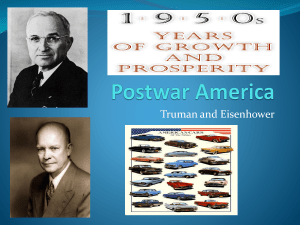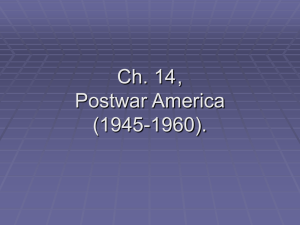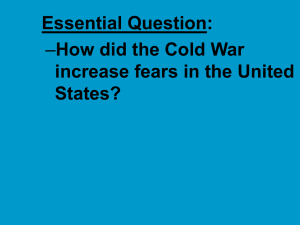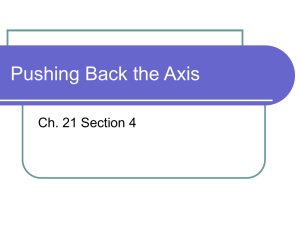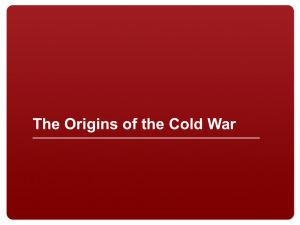Chapter 25 Henretta Power Point(mismatch)
advertisement
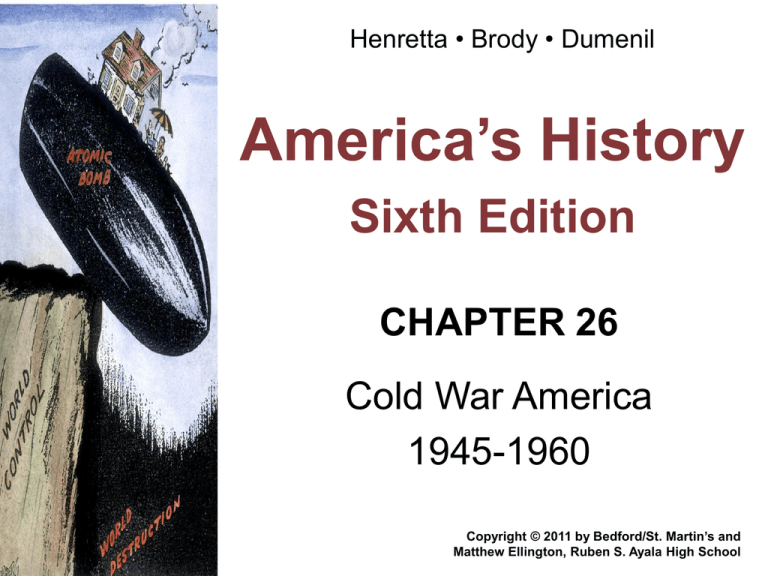
Henretta • Brody • Dumenil America’s History Sixth Edition CHAPTER 26 Cold War America 1945-1960 Copyright © 2011 by Bedford/St. Martin’s and Matthew Ellington, Ruben S. Ayala High School Chapter 26: The Cold War, 1945-1960 1. The Cold War A. Descent into Cold War, 1945-1946 B. Kennan and the Containment Strategy C. Containment in Asia 2. The Truman Era A. Reconversion B. The Fair Deal C. The Great Fear (The Second Red Scare) 3. Modern Republicanism A. B. C. D. E. They Liked Ike The Hidden-Hand Presidency Eisenhower and the Cold war Containment in the Post-Colonial World Eisenhower’s Farewell Address Part 1: The Cold War Section 1A: Descent into Cold War, 1945-1946 • Causes: differences between US & USSR, fate of Eastern Europe, Russia’s desire for a buffer against invasion, WWII conflicts, Truman’s toughness, Stalin’s ruthlessness, eventual arms race • Yalta and Potsdam conferences showed the growing differences between US and USSR Potsdam Conference, 1945 Part 1: The Cold War Sec. 1B: George Kennan and Containment Strategy • Kennan’s “long telegram” urged containment of USSR/communism • Truman Doctrine pledged US support against communism and gave aid to Greece, Turkey • The Marshall Plan provided $13 billion to rebuild Western Europe • The Berlin crisis led to a massive airlift and eventually NATO • NSC-68 urged a massive US military spending increase in response to Soviet atomic bomb and Cold War Part 1: The Cold War Sec. 1C: Containment in Asia • MacArthur oversaw demilitarization and economic rebuilding of Japan • 1949 communist victory in China was blamed on the Democrats • The Korean War: – stalemated after initial seesawing – MacArthur was fired for insubordination – set precedents of not using atomic bombs and undeclared presidential wars Part 2: The Truman Era Section 2A: Reconversion • The sudden end of WWII led to a brief period of inflation and strikes • Republicans and Southern Democrats blocked Truman’s New Deal commitment and passed Taft-Hartley Act weakening unions’ power • Truman was reelected in 1948 in an upset despite Southern conservatives (Dixiecrats) nominating their own candidate WWII vets fight for coal mining jobs, 1946 Part 2: The Truman Era Section 2B: The Fair Deal • Truman desegregated the military and federal government • Employment Act of 1946 asserted government’s role in the economy • The Cold War & Congressional conservatives blocked the Fair Deal New Jersey Phalanx building photograph Part 2: The Truman Era Section 2C: The Great Fear (2nd Red Scare) • Recent research reveals that Soviet spying was prevalent and the fears of that spying and Cold War tensions led to the 2nd Red Scare • Truman’s loyalty program investigated 3 million Americans • HUAC looked into communist influence, especially in Hollywood • Senator McCarthy became a powerful symbol of anti-red hysteria Part 3: Modern Republicanism Section 3A: They Liked Ike • Eisenhower easily won the 1952 election with his huge war popularity • Eisenhower mostly kept New Deal policies as Democrats remained the majority party, controlling Congress for most of Ike’s tenure Part 3: Modern Republicanism Section 3B: The Hidden Hand Presidency • Eisenhower tried to avoid controversy (i.e. McCarthy, civil rights) and worked behind the scenes while seeming above the fray • National Highway Act, NASA, HEW increased government spending • Eisenhower Republicans were part of the “liberal consensus” Eleanor Roosevelt at the Tuskegee Institute Part 3: Modern Republicanism Section 3C: Eisenhower and the Cold War • Eisenhower’s “new look” foreign policy tried to save money and be more effective by relying on brinksmanship and threat of nuclear war • Results: H-bomb, ICBMs, SAC, DEW, nuclear triad, and MAD First H-bomb, 1951 Hungarian Uprising, 1957 Part 3: Modern Republicanism Section 3D: Containment in the Post-Colonial World • US desire to contain communism often led to siding with repression • US signed alliances promising to defend dozens of countries • “Domino Theory” led US into Vietnam after the French were beaten • Eisenhower Doctrine: the US would aid any Middle Eastern country under a communist threat Part 3: Modern Republicanism Section 3E: Eisenhower’s Farewell Address • Eisenhower famously warned of the dangers of the growing “militaryindustrial complex” on American civil liberties in his farewell address • Cold War Impact: climate of fear, arms race, rise of military-industrial complex, economic growth, and expansion of federal government
